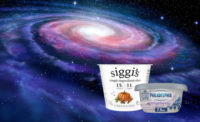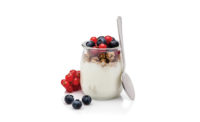It is an age of exploration in the dairy ingredient realm. Suppliers are seeking to boldly go where nobody has ever gone before by developing additives that propel product taste, texture, and nutrition.
The rapidly expanding global dairy ingredients sector will have a compound annual growth rate (CAGR) of 7.2% and a revenue increase from an estimated $63.6 billion in 2021 to $89.9 billion by 2026, projects Northbrook, Ill.-based research firm MarketsandMarkets Inc.
“Healthy eating habits coupled with growing consumption of functional foods among global consumers have been driving the global dairy ingredients market,” the firm states. “Furthermore, growing adoption of vegetarian diets, as dairy is the key source of protein of vegetarian consumers, is also projected to upscale the demand for dairy ingredients.”
Growing interest by health-conscious consumers in nutrition-infused milk powders that is a source of protein, vitamin A, vitamin D, and calcium also is spurring category expansion, MarketsandMarkets reports.
Not only are ingredients evolving to better fortify existing products, but suppliers also are looking to support such newer categories as sports nutrition and energy drinks, says Hari Meletharayil, vice president, dairy products research, for Dairy Management Inc., a Rosemont, Ill.-based trade association.
“Suppliers have to come up with ingredients that function in these different types of products,” he notes. “We need to know what consumers want even before they do.”
Chief among such efforts is the design of products that feature a host of wellness attributes. “Functional ingredients like dietary fiber, prebiotics, probiotics, and protein can shape the nutritional profile of the finished products and boost health benefits,” states Joe O’Neill, vice president of sales and business development for Fairfield, N.J.-based A&B Ingredients Inc. “Low energy-dense carbohydrates such as inulin also are used to reduce fat and may provide a level of sweetness while acting as a prebiotic supporting a healthy and balanced lifestyle.”
Interest in plant-based ingredients and natural solutions that control spoilage and extend shelf life also is increasing, he adds.
In addition, more shoppers are seeking ingredients that support gut health, according to Mike Medina, marketing director, specialized nutrition & dairy, for ADM, a Chicago-based ingredient supplier
“Today’s consumers connect the gut microbiome to overall well-being,” he explains. “This presents dairy developers with an opportunity to further entice shoppers by incorporating microbiome-supporting solutions like prebiotics, probiotics, and postbiotics into finished dairy formulations.”

Health is top of mind
A consumer attitude and usage study by Balchem Inc., a New Hampton, N.Y.-based flavor developer, found that immune support is the most compelling benefit that nutrition-rich foods can address, followed by brain and heart health, notes Renee Beall, Balchem director of marketing for food. Bone health and memory support also elicit above-average interest by consumers, the study reveals. Processors can address such issues by incorporating a range of health-oriented elements in dairy products, including zinc, calcium, vitamin D, and choline for brain health, Beall states.
Products that are low in sugar are becoming more prevalent as well and include flavored dairy beverages, yogurt fruit preps, and frozen desserts, says Thom King, CEO and chief food scientist for Icon Foods Inc., a Portland, Ore.-based provider of sweeteners. “Consumer demand is guiding dairy manufacturers to clean up labels and make deep clean cuts to added sugars,” he states.
Plant-based ingredient use, meanwhile, is occurring in such categories as frozen desserts and milks, says Kelsey Cheadle, senior applications scientist for FlavorSum LLC, a Kalamazoo, Mich.-based flavor supplier. “The drive for non-dairy innovation comes at a time when people are seeking products that align with their dietary goals,” she notes.
“The choice is no longer just between whole and 2% milk, but between dairy and dairy alternatives, which are an ever-growing category,” adds Casey McCormick, vice president of global innovation for Sweegen Inc., a Santa Margarita, Calif.-based sweetener developer. “The non-dairy products provide solutions for consumers with hypercholesterolemia, milk allergy or lactose intolerance.”
Stress and anxiety from the COVID-19 pandemic also is leading consumers to seek new functional foods and supplements that can help restore life balance and provide calm benefits that will also enhance sleep, notes Tom Druke, Balchem director of marketing for the VitaCholine brand. “Ingredients that are associated with relaxation and have broader appeal, like magnesium, can extend the consumer benefits beyond just sleep into mood and relaxation,” he notes.
Along with wellness-oriented ingredients, dairy processors are bolstering products by incorporating brighter colors and unique combinations of herbs, spices, and tropical fruit, such as basil and mango, pink peppercorn and pineapple, and mint and finger lime, ADM’s Medina notes. “These innovations are helping developers bring new functional offerings to the table, as the dairy category continues to adapt to shifting, and sometimes at-odds, desires of consumers who are seeking products that support both permissible indulgence attributes and functional wellness,” he states.
Such products include creamy yogurt with more protein and ice cream with less sugar, Sweegen’s McCormick says. “Winning over consumers means making their healthy choices taste as wonderful as possible,” he stresses.

A multitude of matters to mull
Processors seeking the optimal ingredients for each product, meanwhile, must consider such elements as cost, label claims, allergens, texture, and taste, Cheadle says. “It’s good to establish formulation and label goals, nutritional targets, budget and non-negotiables early when beginning a new project,” she states. “Establishing where you want to focus your energy and budget will help expedite time to market.”
Blends of functional ingredients like proteins with more conventional and lower-priced ingredients can help reduce operating expenses, says Matt Peacock, vice president of business development for Osage Food Products, a Washington, Mo.-based ingredient supplier. “The pricing of most dairy ingredients have increased sharply over the last few years and that is leading companies to seek unique cost-saving measures while maintaining product flavor and texture,” he states.
Dairy processors also can benefit by incorporating multifunctional elements in products, such as calcium and potassium phosphates, in order to limit the amount of product additives and produce labels with shorter and simpler ingredient lists, says Kaylan Hayman, application development manager for Prayon, an Augusta, Ga.-based provider of phosphate and fluorine solutions. Phosphates, for instance, can help stabilize dairy proteins during processing for greater product texture while providing a nutritional bonus, she notes.
“You get the power of improved protein functionality and mineral fortification in a single ingredient,” Hayman explains. “This helps dairy processors create good-for-you products with the straightforward ingredients that consumers are demanding.”
Indeed, with label listings a key concern for many shoppers, it’s important that formulators understand early in the development process what ingredients will be in and out of scope for their consumer bases, says Christine Addington, senior dairy technical service specialist at Cargill Inc., a Minneapolis-based ingredient supplier.
“The main challenge for suppliers is to invest the time and resources necessary to deliver the specific functionality,” adds Anand Rao, vice president of ingredients innovation for Agropur, an Appleton, Wis.-based ingredient supplier and dairy product producer. “Processors can run into the hurdles of higher cost and/or exclusivity requirements for these targeted ingredients that are developed to meet their specific needs.”

Strengthen the supply lines
Supply chain challenges stemming from transportation and labor issues, meanwhile, are limiting the availability of some ingredients and making it important for dairy processors to give their suppliers ample notice of their product needs, Cargill’s Addington says.
“Given current supply chain realities, many of our customers have prioritized making their formulas as flexible as possible,” she notes. “These are unprecedented times and processors need formulas that can bend and flex as the market changes.”
Shortages of hydrocolloids and starches for dairy product stabilization, for instance, remain an issue, says An Ho, director of research and development for International Food Products Corp. (IFPC), a Fenton, Mo.-based ingredient developer. “We are testing alternatives that can function the same way but would incur an ingredient statement change,” she notes, adding that such factors as railroad strikes, increased ingredient costs and consumer preferences are driving formulation changes.
To better minimize ingredient shortfalls, dairy processors should work with suppliers that have a redundant instead of a single supply chain source, King advises. “Planning procurement as far out as possible can secure the supply and also give the processor leverage in pricing,” he notes. Processors also can partially invest in the development of new ingredients or provide purchase commitments to de-risk investments by their suppliers, King suggests.
Agropur’s Rao concurs. “When suppliers and processors can discuss confidential and specific needs, it is easier for the suppliers to identify and recommend appropriate and optimal ingredients,” he adds.
Indeed, processors should work “hand in hand every step of the way” with their ingredient suppliers to clearly emphasize their needs for product functionality, says Rohit Kapoor, Dairy Management Inc. vice president of dairy products research.
“The key is for processors to describe their exact requirements so that suppliers provide the ingredients that will best fit the application,” he notes.
It is vital as well for processors to team with a color supplier that can provide technical support at every stage of the commercialization process, concludes Alice Lee, technical marketing manager for GNT USA LLC, a Tarrytown, N.Y.-based coloring provider.
“Creating colorful dairy products with clean and clear labels requires extensive knowledge and expertise,” she notes. “Providers should include advice on color selection, stability testing, performance, upscaling, regulatory compliance, and quality documentation.”



